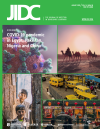Evaluation of Risk Factors for Mortality in Febrile Neutropenia
DOI:
https://doi.org/10.3855/jidc.12520Keywords:
Febrile neutropenia, Hematologic malignity, solid tumor, mortality, invasive fungal infectionAbstract
Introduction: We aimed to evaluate the epidemiology of infections and factors associated with mortality in patients with febrile neutropenia (FEN).
Methodology: The adult patients, who developed FEN after chemotherapy due to a hematologic malignancy or a solid tumor in a training and research hospital were evaluated, retrospectively. The demographic data of the patients, underlying malignancy, administered antimicrobial therapy, microbiological findings, and other risk factors associated with mortality were evaluated.
Results: A total of 135 FEN episodes of 115 patients, who comprised of 72 (63%) patients with 89 FEN episodes due to hematologic malignancies (hemato-group) and 43 (37%) patients with 46 FEN episodes due to solid organ cancers (onco-group), were evaluated in the study. The median age was 47 years (range: 17-75 years) and 66 (57%) patients were male. A total of 12 patients (8.8%) died during 135 episodes of FEN including nine cases from hemato-group and three cases from onco-group. Those factors including a presence of pneumonia, advanced age, persistent fever despite an antimicrobial treatment, and need for mechanical ventilation in intensive care unit (ICU) with were determined as risk factors associated with mortality.
Conclusions: Morbidity and mortality are more common in patients with hematological malignancies compared to patients with solid organ cancers due to prolonged neutropenia. In case of persistent fever, an invasive fungal infection (IFI) should be kept in mind in patients with hematologic malignancies and then antifungal treatment should be initiated. Although a persistent fever is also common in patients with solid tumors, the necessity of antifungal therapy is rare due to the short duration of neutropenia.
Downloads
Published
How to Cite
Issue
Section
License
Authors who publish with this journal agree to the following terms:
- Authors retain copyright and grant the journal right of first publication with the work simultaneously licensed under a Creative Commons Attribution License that allows others to share the work with an acknowledgement of the work's authorship and initial publication in this journal.
- Authors are able to enter into separate, additional contractual arrangements for the non-exclusive distribution of the journal's published version of the work (e.g., post it to an institutional repository or publish it in a book), with an acknowledgement of its initial publication in this journal.
- Authors are permitted and encouraged to post their work online (e.g., in institutional repositories or on their website) prior to and during the submission process, as it can lead to productive exchanges, as well as earlier and greater citation of published work (See The Effect of Open Access).








